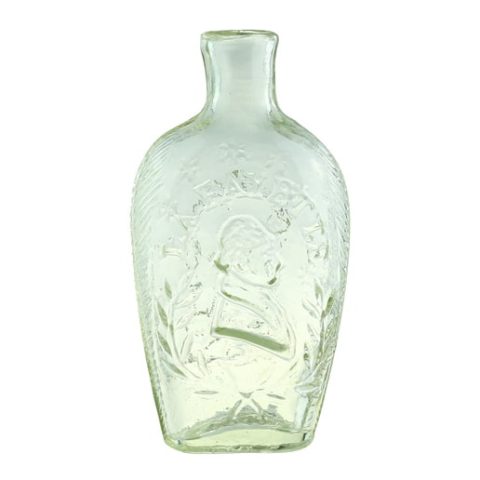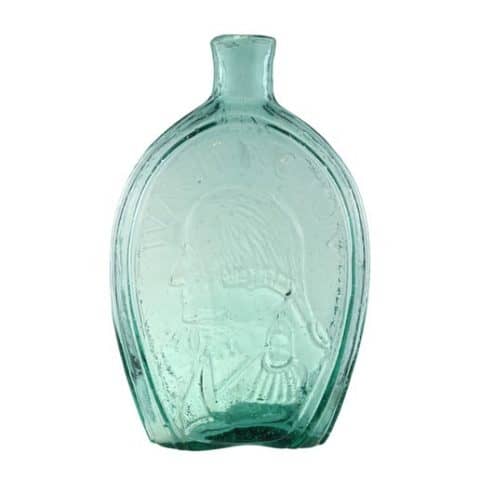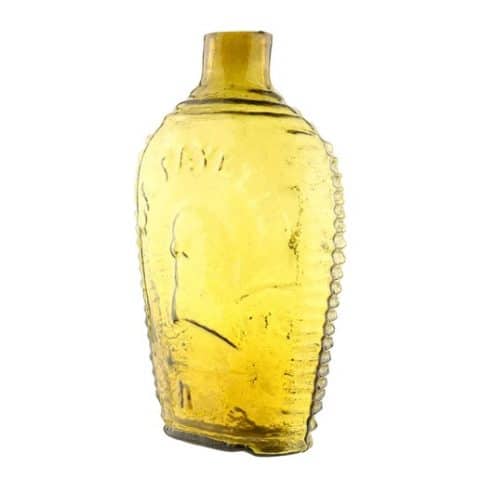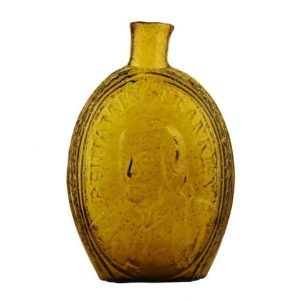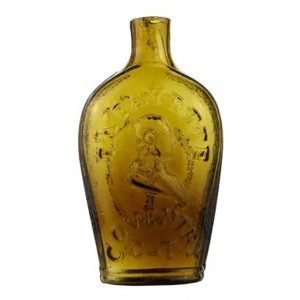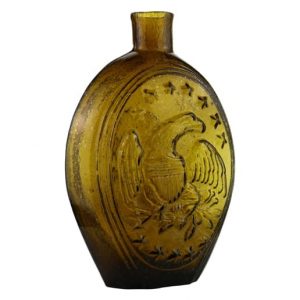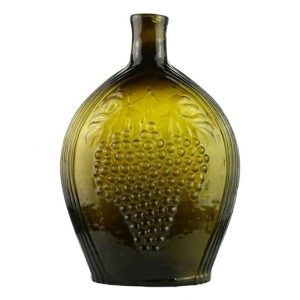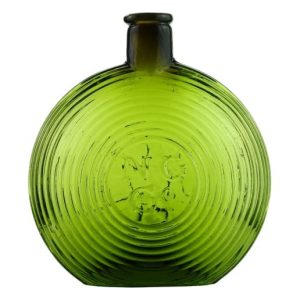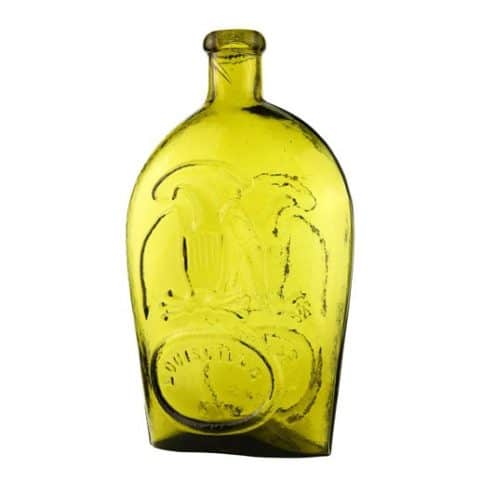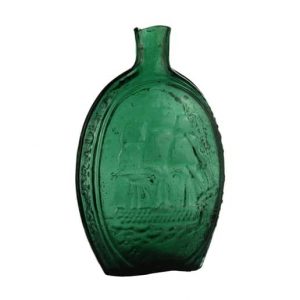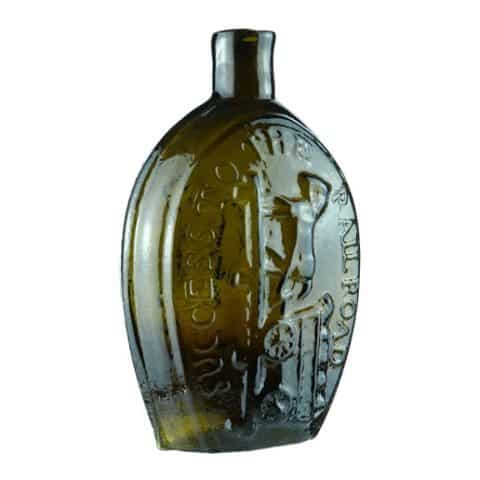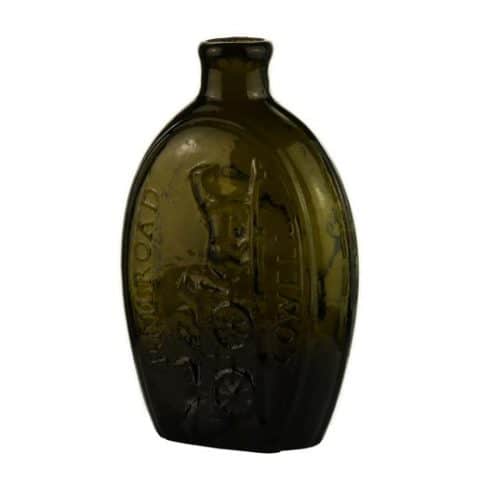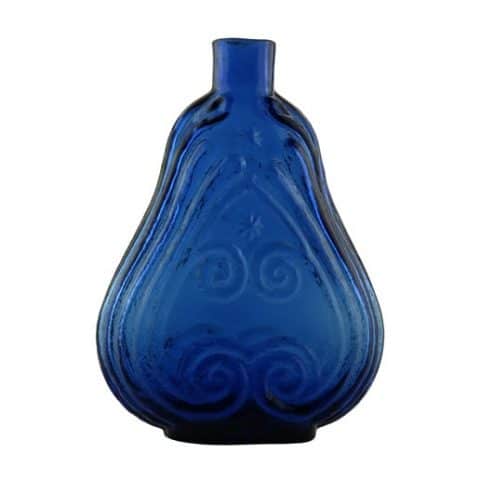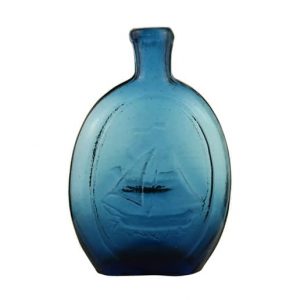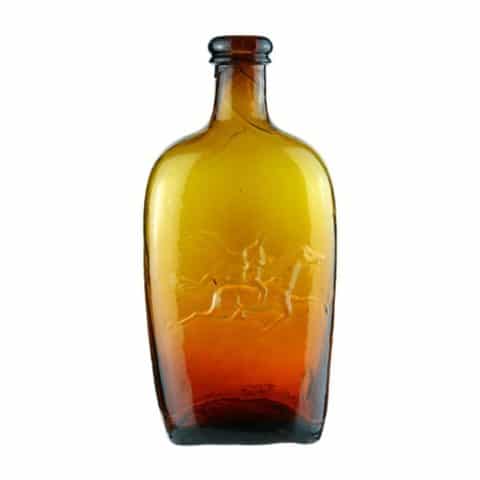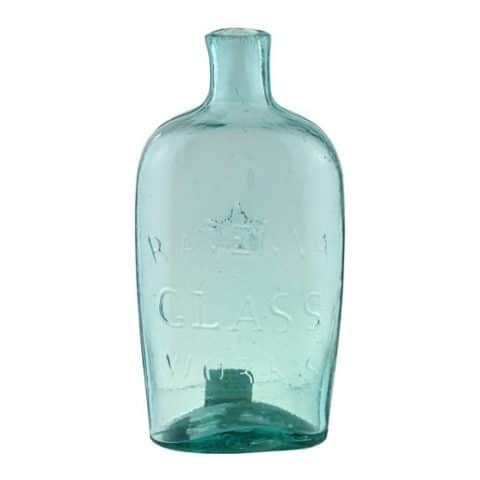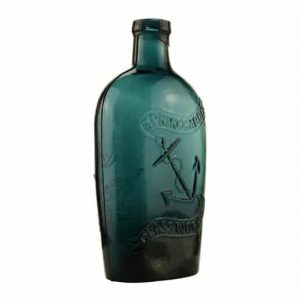GXI-8 • For Pike’s Peak Old Rye – Eagle Flask Pittsburgh Pa
GXI – 8
For Pike’s Peak Old Rye – Eagle Pittsburgh Pa
Historical Flask
Pittsburgh District Glass House
Yellow with Olive Tone Quart
Provenance: Chip Cable Collection

Our Pike’s Peak historical flask commemorates the Pike’s Peak Gold Rush, which was the boom in gold prospecting and mining in the Pike’s Peak Country of western Kansas Territory and southwestern Nebraska Territory of the United States. The rush began in July 1858 and lasted until roughly the creation of the Colorado Territory on February 28, 1861.
This outstanding example of a quart GXI-8 “Prospector – For Pike’s Peak Old Rye – Eagle Pittsburgh Pa” historical flask is typically found in a rich blue aquamarine glass. The yellow with olive tone glass color is an unlisted variant and exceptionally bold color for this flask which was produced in a Pittsburgh District glass house in the mid to later part of the 1860s.

The consignor purchased the flask from two well-known dealers/collectors who bought the collection of Pike’s Peak flasks from the late John M. Eatwell. In 2000, Eatwell and David K. Clint lll published a book titled Pike’s Peak Gold to commemorate Zebulon Montgomery Pike. This book was released at the FOHBC 2000 National Antique Bottle Exposition in Denver, Colorado.

by John M. Eatwell (Author), David K. Clint III (Author)
GXI-8 Prospector – Eagle
The obverse side of the pictorial flask depicts a prospector with a large, tall head, large eye, small ear, big nose, and a grin wearing a large high crowned Derby, swallow-tail coat, tight trousers with thin legs that are bent at the knees, one more than the other. His feet and boots are small. He has a pickaxe and pack (with two other tools showing) in front of the ax head, held by his left hand and resting on his left shoulder. There is a long cane in his right hand. He is walking left on an oblong oval frame that has wide molding. Above the prospector in an arc is the embossed copy reading ‘PIKES PEAK’ in a bold serif typestyle. Within the bottom, oblong molding is embossed horizontal serif copy reading ‘OLD RYE.’

The reverse side of the pictorial flask depicts an American eagle with its head to the left and a long neck. The wings have 10 wide-spaced ribs within the left and 14 fine ribs in the right and are partly raised, spread downward and outward. A sunken shield with five vertical bars and no bottom line is on the breast. There are thunderbolts consisting of three arrows in each talon. From the beak, the eagle holds a long narrow pennant with a point at the end that curves to the right above the eagle. Below the eagle is a large oval frame with wide molding with small embossed serifed copy arching along the inner top of the oval, reading ‘PITTSBURGH PA’ starting at the lower left end and following the upper line of the frame to the center-right end.
The flask sides are plain, the base plain while the neck has an applied mouth with a ring. Our subject flask has a small hole in the base that was expertly repaired according to the consignor. The overall condition and glass character are excellent for this rare-color flask. This flask design can be found in quarts, as in our GXI-8 example, pints (GXI-9), and half-pints GXI-10.

Zebulon Montgomery Pike
Pike’s Peak in Colorado is named after Zebulon Montgomery Pike, born on January 5, 1779, in Lamington, New Jersey. He was the son of Isabella (Brown) and Zebulon Pike and would follow in his father’s footsteps. The latter had begun his career in the United States military service in 1775 at the beginning of the American Revolutionary War.

As a United States Army officer, Zebulon Pike led two expeditions through the Louisiana Purchase under the authority of President Thomas Jefferson. Pike’s expeditions coincided with other Jeffersonian expeditions, including the Lewis and Clark Expedition and the Red River Expedition in 1806. The first Pike expedition in 1805–1806 was to reconnoiter the upper northern reaches of the Mississippi River.
Upon return, Pike was ordered to mount a second expedition to explore, map, and find the headwaters of the Arkansas and Red rivers. Additional objectives of this exploratory expedition into the southwestern part of the Louisiana Territory were to evaluate natural resources and establish friendly relations with Native Americans. Beginning July 15, 1806, Pike led what became known as the “Pike Expedition.”
In early November 1806, Pike and his team sighted and tried to climb to the summit of the peak later named after him. They made it as far as Mt. Rosa, located southeast of Pike’s Peak, before giving up the ascent in waist-deep snow. They had already gone almost two days without food.
The expedition then continued south, searching for the Red River’s headwaters. The group next built a fort for shelter during the winter. However, they had crossed the border through confusion or deliberation, and Spanish colonial authorities captured Pike and some of his party on February 26, 1807, near Santa Fe. Pike and his men were sent to Chihuahua (present-day Mexico) for interrogation. Later in 1807, Pike and some of his men were escorted by the Spanish through Texas and released near American territory in Louisiana.
In 1810, Pike published an account of his expeditions, a popular book that was translated into several languages for publication in Europe. He later achieved the rank of brigadier general in the American Army. He served during the War of 1812 until he was killed during the Battle of York in April 1813, outside the British colonial capital of Upper Canada.
Primary Image: GXI-8 “Prospector For Pike’s Peak Old Rye – Eagle Pittsburgh Pa” historical flask imaged on location by Alan DeMaison, FOHBC Virtual Museum Midwest Studio
Support Image: Auction Lot 82: Prospector And “For Pike’s Peak” – Eagle Historical Flask, Pittsburgh district, Pittsburgh, Pennsylvania, 1860-1870. Bluish aquamarine, applied mouth with ring – smooth base, quart. GXI-8 A strong color and bold embossing. Fine condition. – Norman Heckler Jr. & Sr., Norman C. Heckler & Company, Auction #164
Support: Reference to American Bottles and Flasks and Their Ancestry by Helen McKearin and Kenneth M. Wilson, Crown Publishers Inc., New York, 1978.
Support: Reference to Pike’s Peak Gold by John M. Eatwell & David K. Clint lll
Join the FOHBC: The Virtual Museum is a project of the Federation of Historical Bottle Collectors (FOHBC). To become a member.







